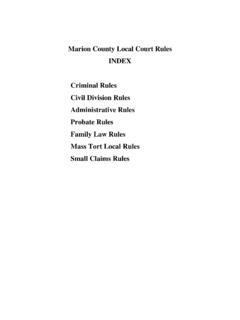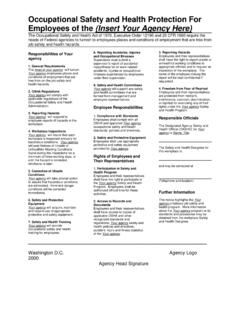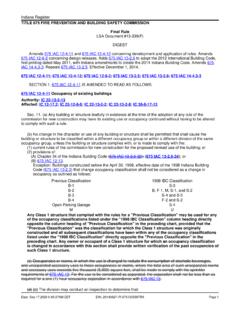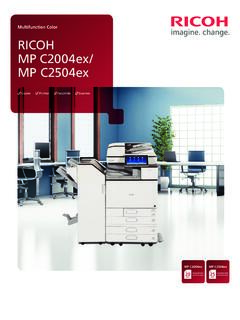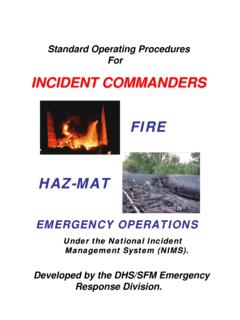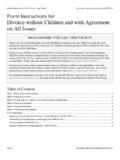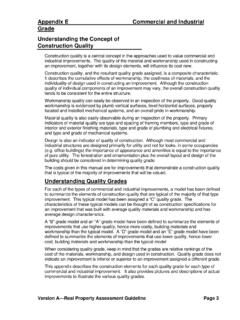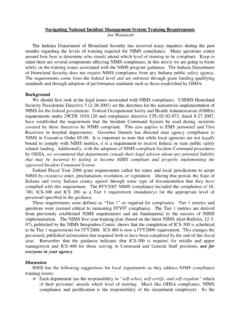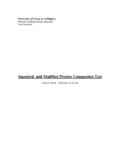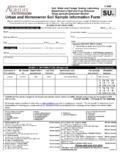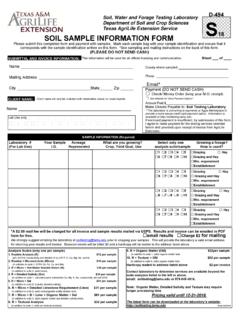Transcription of Field Testing of Soil and Aggregate 5-26-15
1 5/26/15 - 1 - INDIANA DEPARTMENT OF TRANSPORTATION OFFICE OF MATERIALS MANAGEMENT OFFICE OF GEOTECHNICAL SERVICES Field Testing OF soil , GRANULAR soil , AND COARSE Aggregate The procedures for determining the maximum dry density, optimum moisture content, in-place density, in-place strength, and moisture content of soils, granular soil , and coarse aggregates in the Field will be as follows: TEST METHODS Attachment I lists the test methods that will be used to test soils, granular soil , and aggregates. The test methods are as follows: AASHTO T 99 -- Moisture-Density Relations of Soils Using a ( ) Rammer and a 305-mm (12-in.)Drop AASHTO T 191 -- Density of soil In-Place by the Sand-Cone Method AASHTO T 224 -- Correction for Coarse Particles in the soil Compaction Test AASHTO T 255 -- Total Evaporable Moisture Content of Aggregate by Drying ITM 506 -- Field Determination of Moisture Content of Soils ITM 508 -- Field Determination of Deflection Using Light Weight Deflectometer ITM 509 -- Field Determination of Strength Using Dynamic Cone Penetrometer ITM 512 -- Field Determination of Maximum Dry Density and Optimum Moisture Content of Soils SOILS Soils will be defined as cohesive material with more than 35 % passing the No.
2 200 sieve. Soils are further defined as follows: Clay soil soil with a maximum dry density of 114 lb/ft3 or less Silty soil soil with a maximum dry density greater than 11 4 lb/ft3 and less than or equal to 120 lb/ft3 Sandy soil soil with a maximum dry density greater than 120 lb/ft3 5/26/15 - 2 - Options 1 or 2 may be used for each of the following tests, if there is more than one option. Maximum Dry Density and Optimum Moisture Content 1. AASHTO T 99 (Method A) 2. ITM 512 In-Place Density 1. AASHTO T 191* In-Place Strength 1. ITM 509 Moisture Content 1. ITM 506 * Correction for coarse particles will be made in accordance with AASHTO T 224. GRANULAR soil Granular soil will be defined as soil that is non-cohesive with 35 % or less passing the No. 200 sieve. Options 1 or 2 may be used for the following tests, if there is more than one option.
3 Maximum Dry Density and Optimum Moisture Content 1. AASHTO T 99 (Method A or C) In-Place Density 1. AASHTO T 191* In-Place Strength 1. ITM 508 (Granular soils with Aggregate retained on the 3/4 in. sieve, structural backfill sizes 2 in. and 1 in., and b borrow with a similar gradation) 2. ITM 509 (Granular soils with Aggregate that is 100% passing the 3/4 in. sieve, structural backfill sizes 1 in., 1/2 in., No. 4 and No. 30 and b borrow with a similar gradation) Moisture Content 1. ITM 506 * Corrections for coarse particles will be made in accordance with AASHTO T 224. COARSE AGGREGATES Coarse aggregates are defined as having a minimum of 20% retained on the sieve. Coarse aggregates may be tested by Option 1 or 2, if there is more than one option.
4 5/26/15 - 3 - Maximum Dry Density and Optimum Moisture Content 1. AASHTO T 99 (Method C) In-Place Density 1. AASHTO T 191* In-Place Strength 1. ITM 508 (coarse Aggregate sizes No. 43, 53, and 73) Moisture Content 1. AASHTO T 255 (reported to the nearest whole number) * Corrections for coarse particles will be made in accordance with AASHTO T 224. CHEMICAL MODIFIED SOILS Chemical modified soils will be tested with the Dynamic Cone Penetrometer (DCP) or Light Weight Deflectometer (LWD) In-Place Strength 1. ITM 509 2. ITM 508 DRY DENSITY The dry density of the material will be determined as follows: 100 x 1001+=wWW where: W = dry density in lb/ft3 of compacted soil W1 = wet density in lb/ft3 of compacted soil w = moisture content (percent) of sample The dry density and wet density will be reported to the nearest 1 lb/ft3 and the moisture content will be reported to the nearest 1 %.
5 DEFLECTION AND MODULUS WITH LIGHT WEIGHT DEFLECTOMETER (LWD) The LWD test is a portable Falling Weight Deflectometer developed to enable fast Testing of constructed layers of embankment under load conditions to approximate loads imposed by traffic. The LWD criteria will be in accordance with The critical steps in conducting this test procedure in accordance with ITM 508 are as follows: 1. Assure that the load plate is in full contact with the surface of the soil 2. The guide rod is required to be perpendicular to the load plate 5/26/15 - 4 - 3. The falling weight is caught after the weight rebounds from striking the plate 4. A test is considered invalid if the operator does not catch the falling weight after the weight has rebounded from the plate or the load plate moves laterally 5.
6 Drops 1 to 3 are used to seat the load plate and drops 4 to 6 are used to measure the stiffness of the material MOISTURE CONTENT One moisture content test will be required for each day that density or strength measurements are taken. The sample for moisture content is required to be representative of the entire depth of the compaction lift being tested. Additional moisture content tests may be required during the day if there is a failing moisture test or a change in the material. Moisture content may be determined by drying the sample with a stove, hot plate, or microwave oven, or by means of a moisture probe. All tests are required to be in accordance with ITM 506. CHEMICAL MODIFIED SOILS (SECTION 215) Cement, lime, lime by-products, and fly ash are allowed in soil stabilization and modification.
7 The selection of the chemical modifier is recommended by an INDOT Approved Geotechnical Consultant. The DCP or LWD may be used. When the DCP is used, disposable cones are required. Three random test locations will be determined in accordance with ITM 802 for each 1500 lft of chemically modified soil for each 2-lane pavement section. The average of the blow counts obtained at the three locations will be the DCP blow count representing the 1500 lft section. The following requirements for compaction apply when using the DCP: 1. The average DCP blow count will not be less than 17 for the top 6 in. of a 14 in. lift. Blow counts of 15 and above will be used to determine the average. 2. The average DCP blow count will not be less than 16 for the bottom 8 in.
8 Of a 14 in. lift. Blow counts of 14 and above will be used to determine the average. 3. The average DCP blow count will not be less than 20 for an 8 in. lift. Blow counts of 18 and above will be used to determine the average. Locations with test results less than the specified minimum blow counts will be retested and shall be reworked if the minimum blow count is not obtained. DCP criteria for chemical modified soils were developed at optimum moisture content. The moisture content will decrease with an increase in atmospheric temperature. Moisture content tests of the soil are required to be conducted during mixing and the day after mixing and shall be at or above the optimum moisture content. Moisture contents shall be maintained at or above the optimum moisture content for the first 48 h after mixing with quicklime or hydrated lime.
9 The moisture test is required to be conducted for each 4h of chemical and soil mixing. The 5/26/15 - 5 - Contractor is required to verify that the material is 100 % passing the 1 in. sieve and at least 60 % passing the No. 4 sieve. Chemical modified soils may be tested for strength 24h after compaction. Construction traffic or equipment shall not be allowed on the chemical modified soil until the modified soils meet the DCP test requirements. The DCP test for chemical modified soil is discontinued at 25 blow counts if the DCP does not penetrate to the required depth of the layer of the chemical modified soil . Verification of the depth of the treated soil may be determined by spraying phenolpthalene solution on the soil . The LWD may be used for acceptance Testing of chemically modified soils in accordance with SOILS DRYING WITH CHEMICAL MODIFIERS (SECTION 217) For drying soils having moisture over 2% above optimum moisture content, fly ash or lime is allowed to be used.
10 Soils containing greater than 6% by dry weight calcium, magnesium carbonate or organic material, or having a maximum dry density of less than 95 pcf, or with soluble sulfate content greater than 1000 ppm shall not be used. The moisture content of the mixture shall be at the optimum moisture content or above the optimum moisture content as determined by the mix design in accordance with The Contractor is required to perform moisture tests during the day to verify the spread rate application of the flyash or lime. Acceptance of chemically modified soils will be performed on the finished grade with the DCP, gradation tests and moisture tests and will meet the following requirements: 1. A minimum DCP blow count of 20 for 12 in.

